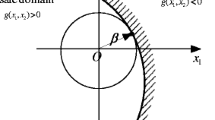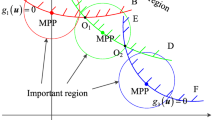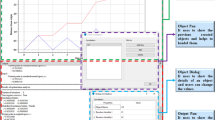Abstract
The reliability analysis of structural systems is generally difficult when limit state function (LSF) is implicitly defined especially by black-box models in engineering. To balance analysis efficiency and accuracy, an improved approach named BIS-FC is proposed in this paper based on the Beta-spherical importance sampling (BIS) framework with the innovative concept of critical region defined by combination with First Order Reliability Method (FORM). The critical region is defined by the hyper-tangent plane of LSF at the Most Probable Point (MPP) and its parallel hyperplanes according to the convex or concave features of LSF, wherein the samples are of both high occurrence probability and high misjudgment risk due to the linearization assumption of FORM. BIS-FC only conducts LSF analysis for the BIS samples located in the critical region, and the other samples are directly identified as safe or failure according to the linearized hyperplanes. Thus large computational cost can be saved compared to the original BIS, and meanwhile, the analysis accuracy can be greatly enhanced compared to FORM. An iterative process is proposed to properly define the critical region, based on which reliability is analyzed sequentially until the stopping criteria for desired estimation error level and stable convergence are satisfied. The algorithms of BIS-FC for both single and multiple MPP situations are developed and testified with six numerical examples and one satellite structural engineering problem. The results demonstrate the effectiveness of BIS-FC regarding good balance between efficiency and accuracy.

















Similar content being viewed by others
References
Ang GL, Ang AHS, Tang WH (2015) Kernel method in importance sampling density estimation. Structural Safety and Reliability
Au SK, Beck JL (1999) A new adaptive importance sampling scheme for reliability calculations. Struct Saf 21:135–158
Bourinet JM, Deheeger F, Lemaire M (2011) Assessing small failure probabilities by combined subset simulation and support vector machines. Struct Saf 33:343–353
Breitung K (1984) Asymptotic approximations for multinormal integrals. J Eng Mech ASCE 110:357–366
Cai X, Qiu H, Gao L, Shao X (2017) Metamodeling for high dimensional design problems by multi-fidelity simulations. Struct Multidiscip Optim 56:151–166
Chen X, Yao W, Zhao Y, Ouyang Q (2016) An extended probabilistic method for reliability analysis under mixed aleatory and epistemic uncertainties with flexible intervals. Struct Multidiscip Optim 54(6):1–12
Cressie N (1990) The origins of kriging mathematical. Geology 22:239–252
Crestaux T, MaıTre OL, Martinez JM (2009) Polynomial chaos expansion for sensitivity analysis. Reliab Eng Syst Saf 94:1161–1172
Du X, Hu Z (2012) First order reliability method with truncated random variables. J Mech Design 134:255–274
Echard B, Gayton N, Lemaire M (2011) AK-MCS: an active learning reliability method combining kriging and Monte Carlo simulation. Struct Saf 33:145–154
Engelund S, Rackwitz R (1993) A benchmark study on importance sampling techniques in structural reliability. Struct Saf 12:255–276
Evans M, Swartz T (1995) Methods for approximating integrals in statistics with special emphasis on Bayesian integration problems. Struct Saf 10:254–272
Gayton N, Bourinet JM, Lemaire M (2003) CQ2RS: a new statistical approach to the response surface method for reliability analysis. Struct Saf 25:99–121
Grooteman F (2008) Adaptive radial-based importance sampling method for structural reliability. Struct Saf 30:533–542
Guan XL, Melchers RE (2001) Effect of response surface parameter variation on structural reliability estimates. Struct Saf 23:429–444
Harbitz A (1986) An efficient sampling method for probability of failure calculation. Struct Saf 3:109–115
Hasofer AM, Lind NC (1974) An exact and invariant first order reliability format. J Eng Mech ASCE
Helton JC, Johnson JD, Sallaberry CJ, Storlie CB (2006) Survey of sampling-based methods for uncertainty and sensitivity analysis. Reliab Eng Syst Saf 91:1175–1209
Hinrichs A (2010) Optimal importance sampling for the approximation of integrals. J Complex 26:125–134
Hohenbichler M, Rackwitz R (1982) First-order concepts in system reliability. Struct Saf 1:177–188
Hu C, Youn BD (2011) Adaptive-sparse polynomial Chaos expansion for reliability analysis and Design of Complex Engineering Systems. Struct Multidiscip Optim 43:419–442
Hu Z, Mahadevan S (2015) Global sensitivity analysis-enhanced surrogate (GSAS) modeling for reliability analysis. Struct Multidiscip Optim 53:501–521
Jiang C, Qiu H, Gao L et al (2017) An adaptive hybrid single-loop method for reliability-based design optimization using iterative control strategy. Struct Multidiscip Optim 56:1271–1286
Kahn H, Marshall AW (1953) Methods of reducing sample size in Monte Carlo computations. J Oper Res Soc Am 1:263–278
Keshtegar B, Chakraborty S (2018) A hybrid self-adaptive conjugate first order reliability method for robust structural reliability analysis. Appl Math Model 53:319–332
Keshtegar B, Hao P (2018) A hybrid descent mean value for accurate and efficient performance measure approach of reliability-based design optimization. Comput Methods Appl Mech Eng 336:237–259
Kiureghian AD, Dakessian T (1998) Multiple design points in first and second-order reliability. Struct Saf 20:37–49
Lee I, Choi KK, Gorsich D (2010) System reliability-based design optimization using MPP-based dimension reduction method. Struct Multidiscip Optim 41:823–839
Lee I, Shin J, Choi KK (2013) Equivalent target probability of failure to convert high-reliability model to low-reliability model for efficiency of sampling-based RBDO. Struct Multidiscip Optim 48:235–248
Li S, Chen L, Chen X, Zhao Y, Bai Y (2017) Long-range AIS message analysis based on the TianTuo-3 micro satellite. Acta Astronaut 136:159–165
Lv Z, Lu Z, Wang P (2015) A new learning function for kriging and its applications to solve reliability problems in engineering. Comput Math Appl 70:1182–1197
Melchers RE (1990) Search-based importance sampling. Struct Saf 9:117–128
Noh, Y., Choi, K. K., & Lee, I. (2008). MPP-based dimension reduction method for RBDO problems with correlated input variables. AIAA/ISSMO Multidisciplinary Analysis and Optimization Conference
Papaioannou I, Papadimitriou C, Straub D (2016) Sequential importance sampling for structural reliability analysis. Struct Saf 62:66–75
Rosenblatt M (1952) Remarks on a multivariate transformation. Ann Math Stat 23:470–472
Song BF (1990) A numerical integration method for computing structural system reliability. Comput Struct 36:65–70
Sun Z, Wang J, Li R, Tong C (2017) LIF: a new kriging based learning function and its application to structural reliability analysis. Reliab Eng Syst Saf 157:152–165
Wang Z, Wang P (2016) Accelerated failure identification sampling for probability analysis of rare events. Struct Multidiscip Optim 54:1–13
Yao W, Chen X, Huang Y, Van TM (2013a) An enhanced unified uncertainty analysis approach based on first order reliability method with single-level optimization. Reliab Eng Syst Saf 116:28–37
Yao W, Chen X, Luo W, Tooren MV, Guo J (2011) Review of uncertainty-based multidisciplinary design optimization methods for aerospace vehicles. Prog Aerosp Sci 47:450–479
Yao W, Chen X, Ouyang Q, Tooren MV (2013b) A reliability-based multidisciplinary design optimization procedure based on combined probability and evidence theory. Struct Multidiscip Optim 48:339–354
Yun W, Lu Z, Jiang X (2018) A modified importance sampling method for structural reliability and its global reliability sensitivity analysis. Struct Multidiscip Optim 57:1625–1641
Zou T, Mahadevan S, Mourelatos Z, Meernik P (2002) Reliability analysis of automotive body-door subsystem. Reliab Eng Syst Saf 78:315–324
Acknowledgements
This work was supported in part by National Natural Science Foundation of China under Grant No.51675525 and 11725211.
Author information
Authors and Affiliations
Corresponding author
Additional information
Responsible Editor is KK Choi
Publisher’s Note
Springer Nature remains neutral with regard to jurisdictional claims in published maps and institutional affiliations.
Rights and permissions
About this article
Cite this article
Yao, W., Tang, G., Wang, N. et al. An improved reliability analysis approach based on combined FORM and Beta-spherical importance sampling in critical region. Struct Multidisc Optim 60, 35–58 (2019). https://doi.org/10.1007/s00158-019-02193-y
Received:
Revised:
Accepted:
Published:
Issue Date:
DOI: https://doi.org/10.1007/s00158-019-02193-y




